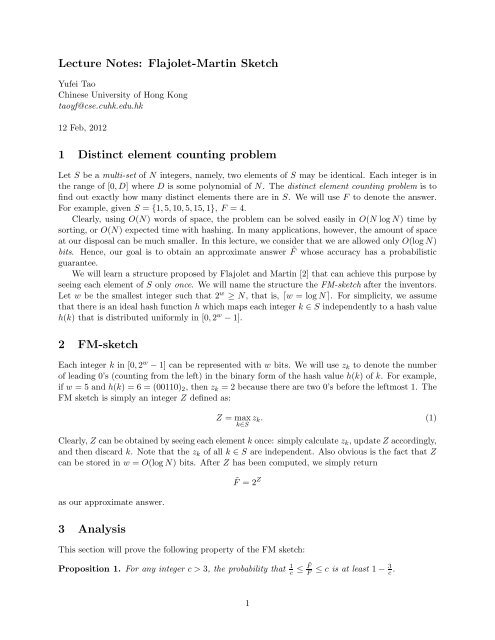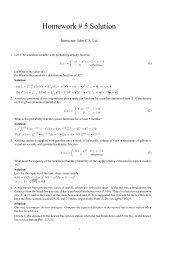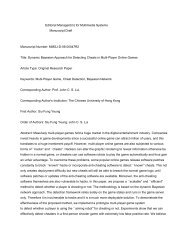Lecture Notes: Flajolet-Martin Sketch 1 Distinct element counting ...
Lecture Notes: Flajolet-Martin Sketch 1 Distinct element counting ...
Lecture Notes: Flajolet-Martin Sketch 1 Distinct element counting ...
You also want an ePaper? Increase the reach of your titles
YUMPU automatically turns print PDFs into web optimized ePapers that Google loves.
<strong>Lecture</strong> <strong>Notes</strong>: <strong>Flajolet</strong>-<strong>Martin</strong> <strong>Sketch</strong><br />
Yufei Tao<br />
Chinese University of Hong Kong<br />
taoyf@cse.cuhk.edu.hk<br />
12 Feb, 2012<br />
1 <strong>Distinct</strong> <strong>element</strong> <strong>counting</strong> problem<br />
Let S be a multi-set of N integers, namely, two <strong>element</strong>s of S may be identical. Each integer is in<br />
the range of [0,D] where D is some polynomial of N. The distinct <strong>element</strong> <strong>counting</strong> problem is to<br />
find out exactly how many distinct <strong>element</strong>s there are in S. We will use F to denote the answer.<br />
For example, given S = {1,5,10,5,15,1}, F = 4.<br />
Clearly, using O(N) words of space, the problem can be solved easily in O(N logN) time by<br />
sorting, or O(N) expected time with hashing. In many applications, however, the amount of space<br />
at our disposal can be much smaller. In this lecture, we consider that we are allowed only O(logN)<br />
bits. Hence, our goal is to obtain an approximate answer ˜ F whose accuracy has a probabilistic<br />
guarantee.<br />
We will learn a structure proposed by <strong>Flajolet</strong> and <strong>Martin</strong> [2] that can achieve this purpose by<br />
seeing each <strong>element</strong> of S only once. We will name the structure the FM-sketch after the inventors.<br />
Let w be the smallest integer such that 2 w ≥ N, that is, ⌈w = logN⌉. For simplicity, we assume<br />
that there is an ideal hash function h which maps each integer k ∈ S independently to a hash value<br />
h(k) that is distributed uniformly in [0,2 w −1].<br />
2 FM-sketch<br />
Each integer k in [0,2 w −1] can be represented with w bits. We will use zk to denote the number<br />
of leading 0’s (<strong>counting</strong> from the left) in the binary form of the hash value h(k) of k. For example,<br />
if w = 5 and h(k) = 6 = (00110)2, then zk = 2 because there are two 0’s before the leftmost 1. The<br />
FM sketch is simply an integer Z defined as:<br />
Z = max<br />
k∈S zk. (1)<br />
Clearly, Z canbeobtainedbyseeingeach <strong>element</strong>k once: simplycalculate zk, updateZ accordingly,<br />
and then discard k. Note that the zk of all k ∈ S are independent. Also obvious is the fact that Z<br />
can be stored in w = O(logN) bits. After Z has been computed, we simply return<br />
as our approximate answer.<br />
3 Analysis<br />
˜F = 2 Z<br />
This section will prove the following property of the FM sketch:<br />
Proposition 1. For any integer c > 3, the probability that 1<br />
c<br />
1<br />
≤ ˜F<br />
F<br />
≤ c is at least 1− 3<br />
c .
Our proof is based on [1]. We say that our algorithm is correct if 1 ˜F<br />
c ≤ F ≤ c (i.e., our estimate<br />
˜F is off by at most a factor of c, from either above or below). The above proposition indicates that<br />
our algorithm is correct with at least a constant probability 1− 3<br />
c > 0.<br />
Lemma 1. For any integer r ∈ [0,w], Pr[zk ≥ r] = 1<br />
2 r.<br />
Proof. Note that zk ≥ r means that the hash value h(k) of k is between 0...0 0...0 and 0...01...1,<br />
namely, between 0 and 2 w−r −1. Remember that h(k) is uniformly distributed from 0 to 2 w −1.<br />
Hence:<br />
Let us fix an r. For each k ∈ S, define:<br />
Pr[zk ≥ r] = 2w−r 1<br />
=<br />
2w 2r. xk(r) =<br />
� 1 if zk ≥ r<br />
0 otherwise<br />
By Lemma 1, we know that xk(r) takes 1 with probability 1/2 r . Hence:<br />
Also define:<br />
Let:<br />
E[xk(r)] = 1/2 r<br />
var[xk(r)] = 1<br />
2 r<br />
X(r) = �<br />
distinct k ∈ S<br />
�<br />
1− 1<br />
2 r<br />
�<br />
xk(r).<br />
r1 = the smallest r such that 2 r > cF<br />
r2 = the smallest r such that 2 r ≥ F<br />
c<br />
Lemma 2. Our algorithm is correct if X(r1) = 0 and X(r2) �= 0.<br />
Proof. Our algorithm is correct if Z as given in (1) satisfies r2 ≤ Z < r1, due to the definitions of r1<br />
and r2. If X(r1) = 0, it means that no k ∈ S gives an zk ≥ r1; this implies Z < r1 (see again (1)).<br />
Likewise, if X(r2) �= 0, it means that at least one k ∈ S gives an zk ≥ r2; this implies Z ≥ r2.<br />
Next, we will prove that the probability of having “X(r1) = 0 and X(r2) �= 0” is at least<br />
1−3/c. Towards this, we will consider the complements of these two events, namely: X(r1) ≥ 1<br />
and X(r2) = 0. We will prove that X(r1) ≥ 1 can happen with probability at most 1/c, whereas<br />
X(r2) = 0 can happen with probability at most 2/c. then it follows from the union bound that<br />
the probability of at least one of the two events happening is at most 3/c. This is sufficient for<br />
establishing Proposition 1.<br />
Lemma 3. Pr[X(r1) ≥ 1] < 1/c.<br />
2<br />
����<br />
r<br />
����<br />
w−r<br />
����<br />
r<br />
����<br />
w−r<br />
(2)<br />
(3)
Proof.<br />
Hence, by Markov inequality, we have:<br />
Lemma 4. Pr[X(r2) = 0] < 2/c.<br />
E[X(r1)] = �<br />
distinct k ∈ S<br />
(by (2)) = F/2 r1<br />
(by definition of r1) < 1/c.<br />
Pr[X(r1) ≥ 1] ≤ E[X(r1)] < 1/c.<br />
Proof. Same as the proof of the previous lemma, we obtain:<br />
E[X(r2)] = F/2 r2<br />
E[xk(r1)]<br />
As X(r2) is the sum of F independent variables, each of which has variance 1<br />
2<br />
tion 3), we know:<br />
var[X(r2)] = F<br />
2r2 �<br />
1− 1<br />
2r2 �<br />
< F<br />
. r2 2<br />
Thus:<br />
r(1− 1<br />
Pr[X(r2) = 0] = Pr � X(r2)−E[X(r2)] = E[X(r2)] �<br />
���X(r2)−E[X(r2)] ≤ Pr<br />
� �<br />
� = E[X(r2)]<br />
���X(r2)−E[X(r2)] ≤ Pr<br />
� �<br />
� ≥ E[X(r2)]<br />
(by Chebyshev inequality) ≤ var[X(r2)]<br />
(E[X(r2)]) 2<br />
<<br />
= 2r2<br />
F<br />
F/2r2 (F/2r2) 2<br />
2 r) (see Equa-<br />
From the definition of r2, we know that 2 r2 < 2F/c (otherwise, r2 would not be the smallest r<br />
satisfying 2 r ≥ F/c). Combining this with the above gives Pr[X(r2) = 0] < 2/c.<br />
4 Boosting the success probability<br />
Proposition 1 shows that our estimate ˜ F is accurate up to a factor c > 3 with probability at least<br />
1−3/c. The success probability 1−3/c does not look very impressive: ideally, we would like to be<br />
able to succeed with a probability arbitrarily close to 1, namely, 1−δ where δ > 0 can be arbitrarily<br />
small. It turns out that we are able to achieve this with a simple median trick for c > 6.<br />
Let us build s independent FM-sketches, each of which is constructed as explained in Section 2.<br />
The value of s will be determined later. From each FM-sketch, we obtain an estimate ˜ Fi (1 ≤ i ≤ s)<br />
of F. We determine our final estimate ˜ F as the median of ˜ F1,..., ˜ Fs. Now we prove that this trick<br />
really works:<br />
3
Theorem 1. For each constant c > 6, there is an s = O(log 1<br />
δ<br />
with probability at least 1−δ.<br />
) ensuring that F<br />
c ≤ ˜ F ≤ cF happens<br />
Proof. For each i ∈ [1,s], define xi = 0 if ˜ Fi ∈ [F/c,cF], or 1 otherwise. From Proposition 1, we<br />
know that Pr[xi = 1] is at most ρ = 3/c < 1/2. Clearly, E[xi] = ρ. Let<br />
Hence:<br />
X =<br />
s�<br />
xi.<br />
i=1<br />
E[X] = sρ.<br />
If X < s/2, then F<br />
c ≤ ˜ F ≤ cF definitely holds. To see this, consider ˜ F > cF. Since ˜ F is<br />
the median of ˜ F1,..., ˜ Fs, it follows that at least s/2 of these estimates are above cF, contradicting<br />
X < s/2. Likewise, ˜ F cannot be smaller than F/c either.<br />
We will show that X < s/2 happens with probability at least 1−δ. Towards this, we argue that<br />
the complement event X ≥ s/2 happens with probability at most δ. As x1,...,xs are independent,<br />
we have:<br />
To make the above at most δ, we need<br />
Hence. setting s = ⌈(1/2−ρ)<br />
2 ln 2<br />
δ<br />
References<br />
Pr[X ≥ s/2] = Pr[X −E[X] ≥ s/2−E[X]]<br />
(as E[X] = sρ < s/2) ≤ Pr[|X −E[X]| ≥ s/2−E[X]]<br />
(by Chernoff bound) ≤ 2e −(1/2−ρ)2<br />
3ρ 2 sρ<br />
3ρ<br />
s ≥<br />
= Pr[|X −E[X]| ≥ s/2−sρ]<br />
�<br />
= Pr |X −E[X]| ≥ 1/2−ρ<br />
�<br />
·sρ<br />
ρ<br />
= 2e −s(1/2−ρ)2<br />
3ρ<br />
3ρ 2<br />
ln<br />
(1/2−ρ) 2 δ .<br />
1 ⌉ = O(log δ ) fulfills the requirement.<br />
[1] N. Alon, Y. Matias, and M. Szegedy. The space complexity of approximating the frequency<br />
moments. Journal of Computer and System Sciences (JCSS), 58(1):137–147, 1999.<br />
[2] P. <strong>Flajolet</strong>andG.N.<strong>Martin</strong>. Probabilistic<strong>counting</strong>. InProceedings of Annual IEEE Symposium<br />
on Foundations of Computer Science (FOCS), pages 76–82, 1983.<br />
4






